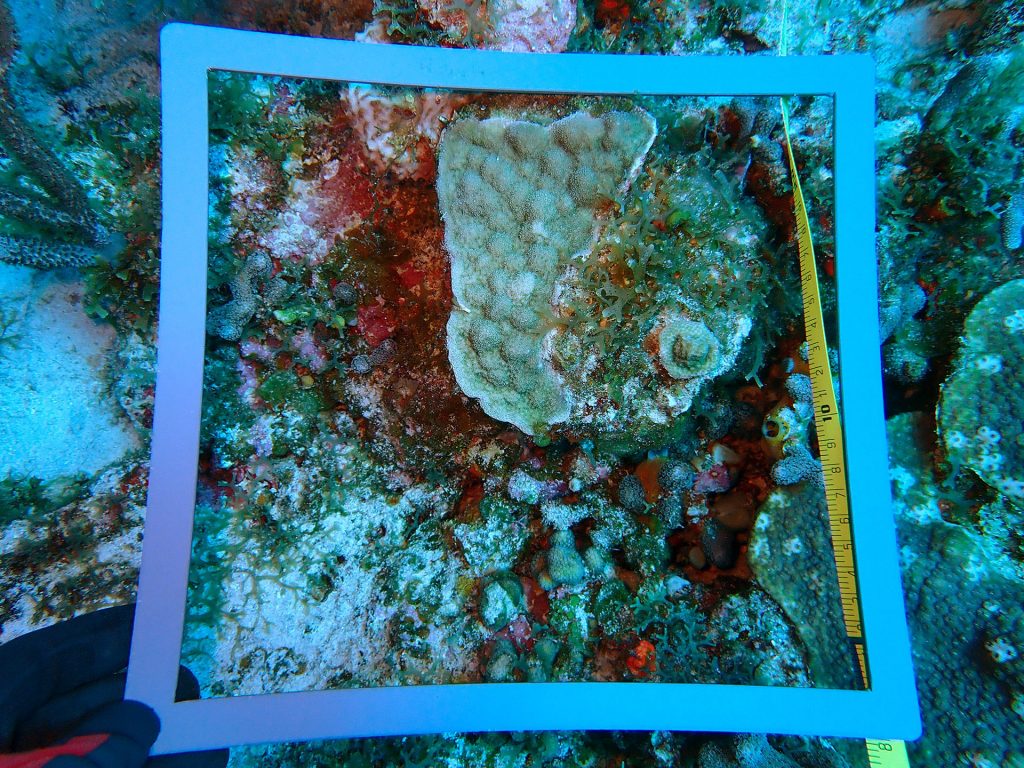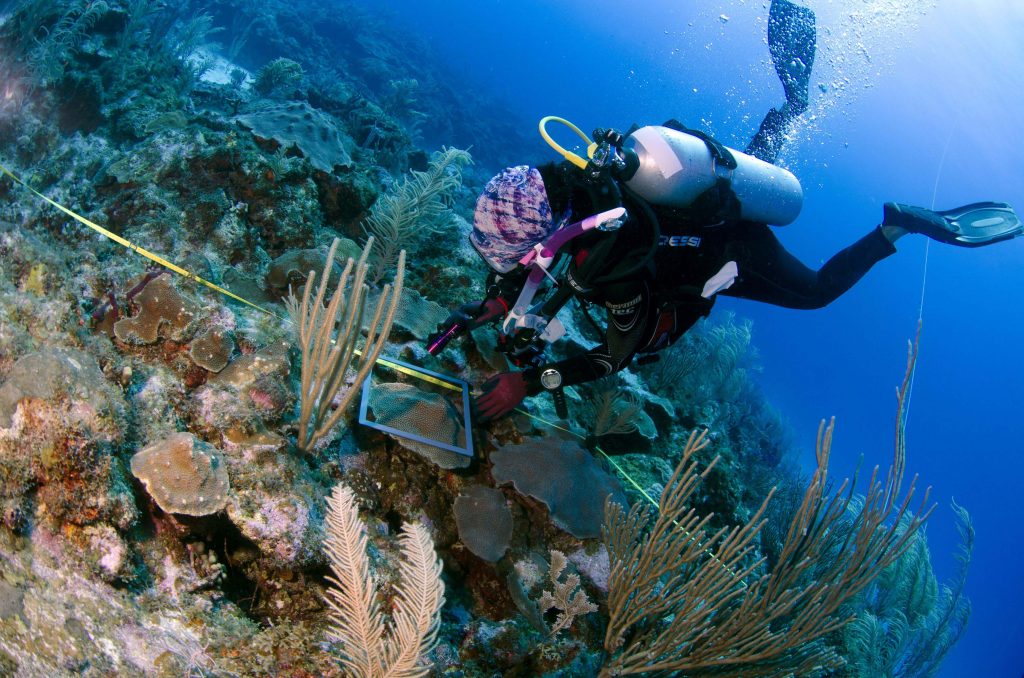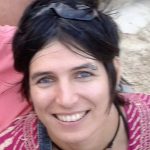A recruit a day keeps the doctor away…
Crossing to first spot
As I write this blog, the mobile phones are flying away and I have to stop my laptop not to fall down from the table. We spent the night in the lee of the island of Saba and are now on our way to the first dive spot of today at the Saba Bank. I am one of the few lucky ones who did not become seasick yesterday. Fingers crossed for today!

Impression of the working conditions with the island of Saba in the background (Photo: Oscar Bos)
Young corals
My task during this expedition is monitoring the presence of young corals (known as “coral recruitment”). Together with biology student Tamara DaCosta, I inspect 30 points along the transect lines for the presence of young corals (0.5 to 4 cm in diameter). We also look at turf and macro algae, which can over grow or compete with young corals (recruits). The presence of recruits indicates a good health of the coral reef.
So far we have mainly found recruits of brooding coral species, such as the mustard hill coral Porites astreoides. Larvae of this type of corals develop after fertilization inside the coral polyps of the mother colony, instead of free-living in the water column. These larvae will often settle near the mother reef. This contrasts with “broadcast spawning” coral species where the fertilization and development of the larvae takes place in the water column. Such larvae will more likely settle far away from the mother reef if they survive this phase.

Close-up young mustard hill coral (Porites astreoides) and an Agaricia spp. in competition with various (macro) algae (including Dictyota spp.) (photo: Miriam Schutter)

Quadrant within which recruiters are counted (photo: Miriam Schutter)
We hope to find also more young corals of the latter species in the coming days, because that means there is an exchange between the Saba Bank and other reefs.
Intensive job
The monitoring of coral recruits is an intensive job. We carefully inspect every plot of 25×25 cm2 for corals, inside every crevice and underneath all swaying algae. As there is no red light at a depth of 20-30 m (everything looks blue), it helps to search the substrate using a small torch. Due to our intensive research we unfortunately do not always see what is happening around us, such as various visits of sharks, rays and turtles. Nevertheless, during the joint ascent to the water surface I saw a big nurse shark, which was taking a nap nearby our transects!

Miriam at work (photo: Frank Mazeas)
Erik’s point
I’m going to get ready for the third dive today, on the edge of the Saba Bank: Erik’s point. Hopefully the high waves will calm down a little bit so that we can “easily” get in and out of the water. Because it can get rough and spooky on the Saba Bank!
Erik’s nightmare
And rough it gets indeed! The third dive turned out to be more difficult than expected … there was a lot of current and high waves: for a number of divers of the second team who were dropped in the water last it was not possible anymore to get to the anchor buoy. I have also kicked my legs in vain to never reach the buoy. We have been taken back on board without doing our dive. Eventually the other divers were taken off the water with a boat at the end of their dive! It was quite an effort! Everyone is dead tired now … and for tomorrow we have to come up with a better plan with the crew of the ship to avoid this kind of ‘rescue missions’!


Hi Eelco! Thanks! Spending the night on the Saba Bank while monitoring dive sites farther away from the island of Saba was actually even more challenging! I’ll keep you posted of any new adventures to come!
Hi Wendy, thanks! Even now that we’ve returned from sea, my world is still rocking with the waves..! 🙂
Hoi Paul! Dat is lang geleden! Het was prachtig op de Saba Bank en de weersomstandigheden op zee waren zeer avontuurlijk! 🙂 Je naam kwam nog te sprake in één van de gesprekken met Erik, kleine wereld leven we in hè! groeten, miriam
Hi Miriam, wist niet dat je ook mee was. Welkom op de Sababank. Ik hoop dat het weer mee blijft werken.
That sounds really intense, hopefully the weather will spare you a bit the rest of the trip. Keep up the good work, we are looking forward to hear more about your adventures!
We’re proud of you Miriam, taking care of the babies inspite of the tumultuous weather. The hand that rocks the cradle is the hand that rules the world…